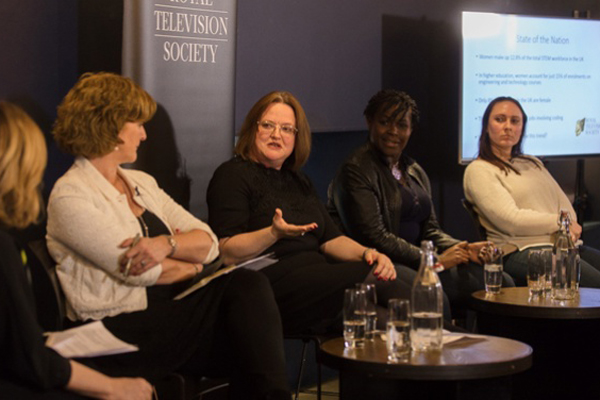
This week at London’s Hospital Club, the Royal Television Society held a conference called “Breaking Barriers: How can the TV industry encourage more women into technology jobs?”. Attended by women from around the UK film and TV industry – from students to top network execs – the event featured an interactive panel which explored the challenges women face in entering the media tech jobs.
On the panel were Sara Putt, deputy chair of Women in Film and Television and head of the Sara Putt Associates agency, Sinead Greenaway, chief technology and operations officer at UKTV, space scientist and The Sky At Night presenter Maggie Aderin-Pocock MBE and OBstv sound engineer, Anna Patching. The panel was moderated by Maggie Philbin OBE, CEO of the education initiative Teen Tech.
The panelists and attendees traded experience and insight on the problem of female under-representation in industry technology jobs. The evening opened with host Maggie Philbin presenting some shameful statistics:
– Women make up 12.8% of the total STEM (science, technology, engineering maths) workforce
– In higher education, women account for 15% of enrollment in engineering and technology courses
– Only 8% of engineers in the UK are female (4% for jobs involving coding)
Finding role models
One of the key block to getting qualified women interested in the TV tech fields is a lack of high visibility role models. Philbin cited the “CSI effect”, which saw the number of women entering forensic science explode with the success of the CSI TV series franchise.
Maggie Aderin-Pocock frequently speaks at schools. “The kids get lit up by TV. I tell them I’m a space scientist, but what they really get excited about is TV. And they don’t realise how many different areas science is involved in.
“Girls can get quite blinkered. They don’t know any other engineers. Some people are just lucky to be exposed to it. They have a brother or a dad who worked in it. We need to get out and sell it to them.”
A corporate role model for the future is being carved out by companies like UKTV. The company is 60% female at every level, said Sinead Greenaway. “And we encourage people to move around the organisation. I’ve just moved a couple women from operational into testing. We allow people to move into technical jobs that they may not have considered…We hire for potential rather than ability.”
Sarah Putt, who, through her agency, works extensively with below the line crew, agreed with the need for role models and an engaged community of peers for women trying to build and expand a career.
“There are lots of small companies and freelancers now. There isn’t that employment mechanism and duty of care with an HR department that you used to have. You need to look at people whose careers you’d like to emulate. And in technical areas it’s difficult.”
A great place to thrive
UKTV has become a very successful multichannel broadcaster, with growth that is ongoing. Greenaway suggested the company’s outlook and its success may not be entirely coincidental.
Greenaway noted that some aspects of broadcast might appeal particularly to women: “It’s an industry where people don’t judge what you look like. It’s creative, teams are solving problems. You can do that in jeans and trainers. It’s such a great place to thrive, where it’s your work that’s judged, not what you’re wearing.”
The discussion circled back again and again to the need for early education, to let girls, young women, and even women mid-career know the technology the sectors were abundant with potential career paths and that, more importantly, science and tech could be thrilling no matter what your gender.
The RTS’s Terry Marsh, event producer for RTS and Jury Chair of the RTS Young Technologist of the Year, spoke from the audience about her activities educating young people about the opportunities in tech and science jobs. As an educator, she realised had special opportunities to foster growth and awareness.
“When I do a programme for school, I tell them you have to send us an equal number of boys and girls. If they say, ‘Oh, we won’t be able to do that”, we say ‘You will. Or we cancel”, and they find a way. If you offer education to school, you can lay down the terms.”
Many paths
Sound engineer Anna Patching decided she wanted to go into outside broadcast from early on. She had a boyfriend who’s dad worked on sound for big festival shows, so she knew that OB existed as a potential career path. But she notes from the outside, the industry can seem quite impenetrable.
“The problem is how to get people to apply in the first place. I wouldn’t apply for some of these jobs. There’s an idea that to be an engineer or a scientist you have to have all A-stars in school. I myself wouldn’t have met the criteria to get on the BBC apprenticeship scheme, for example. But there are many paths open to you. You don’t have to be top of the class.”
In fact, in the UK, female secondary school students do better at physics than males, so talent is not lacking. What is lacking is encouragement and role models, as well as an industry ready to receive and nurture that female talent when it does say “yes’ to our industry.







